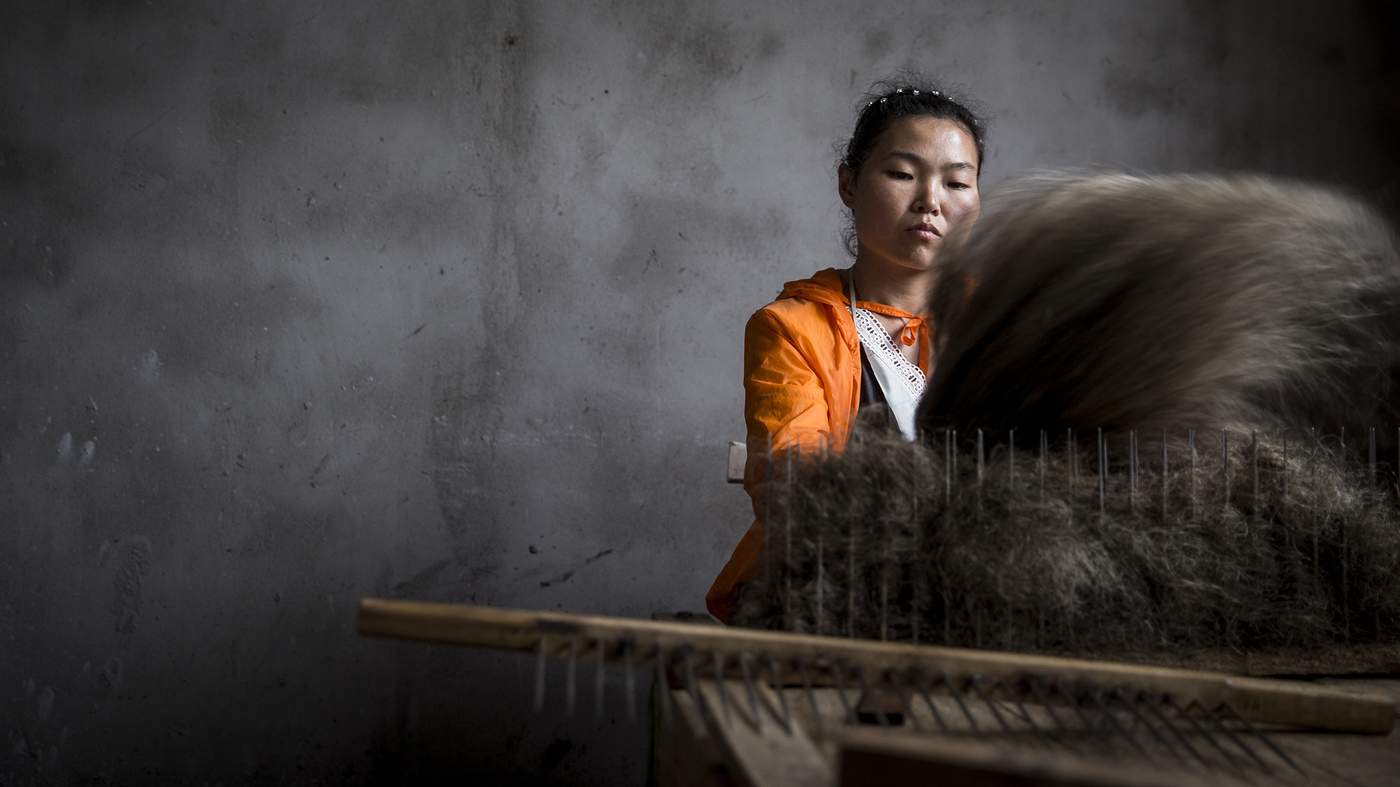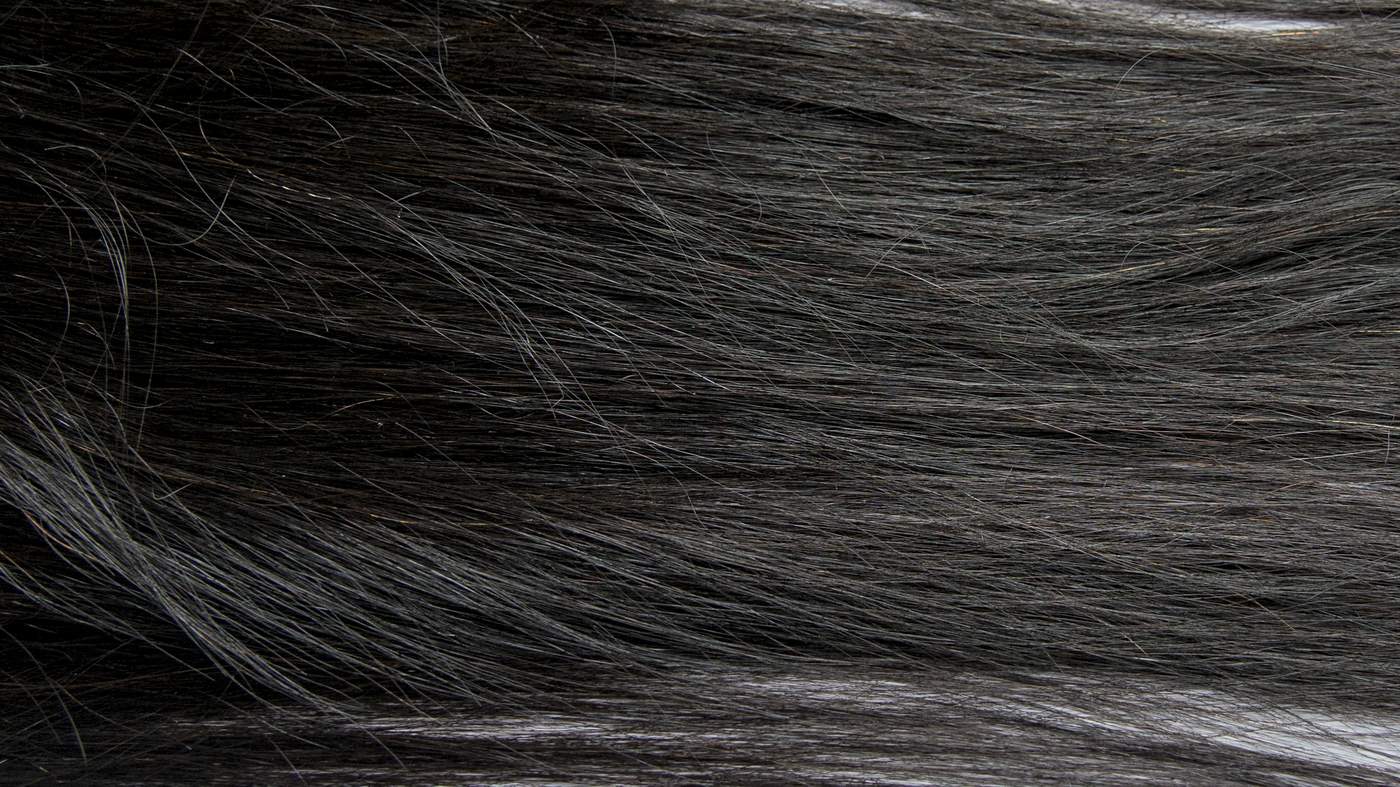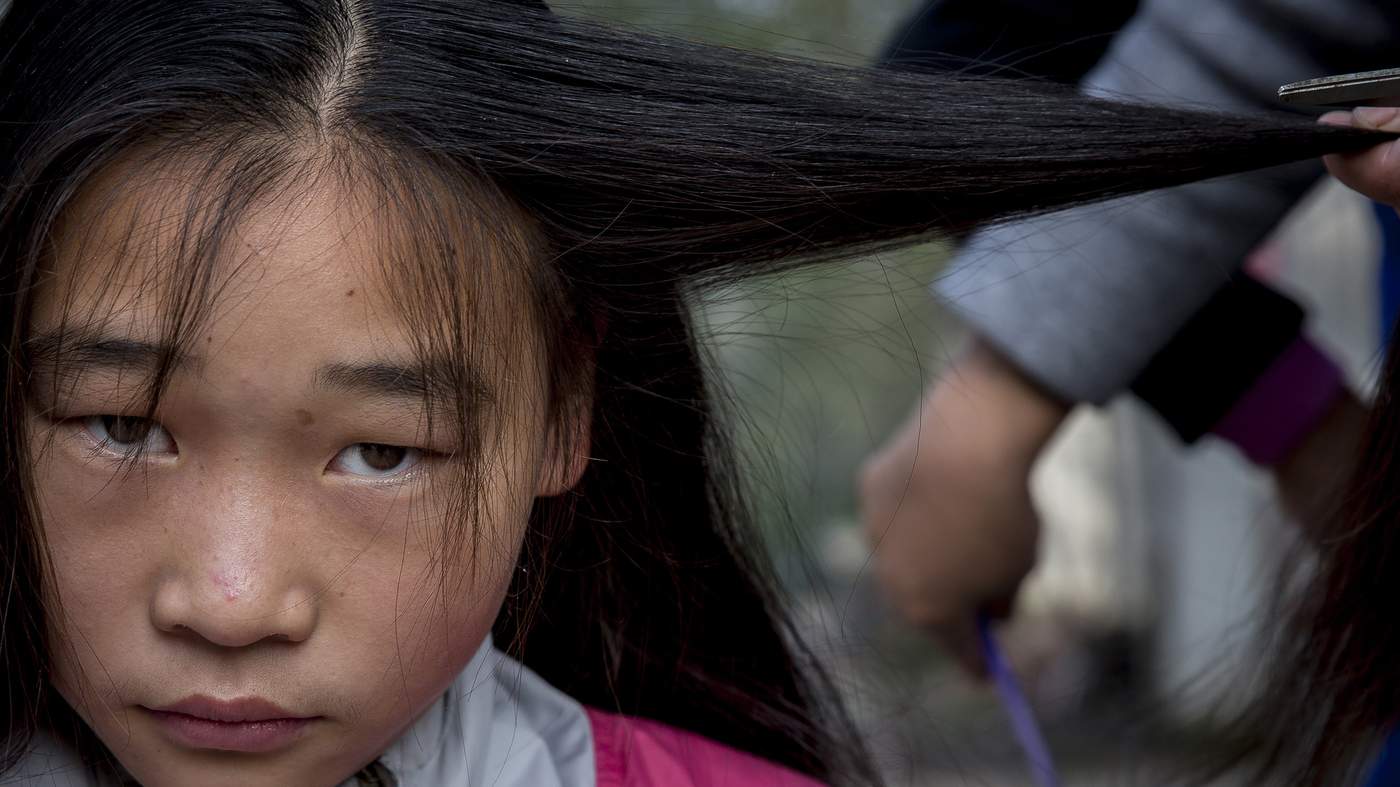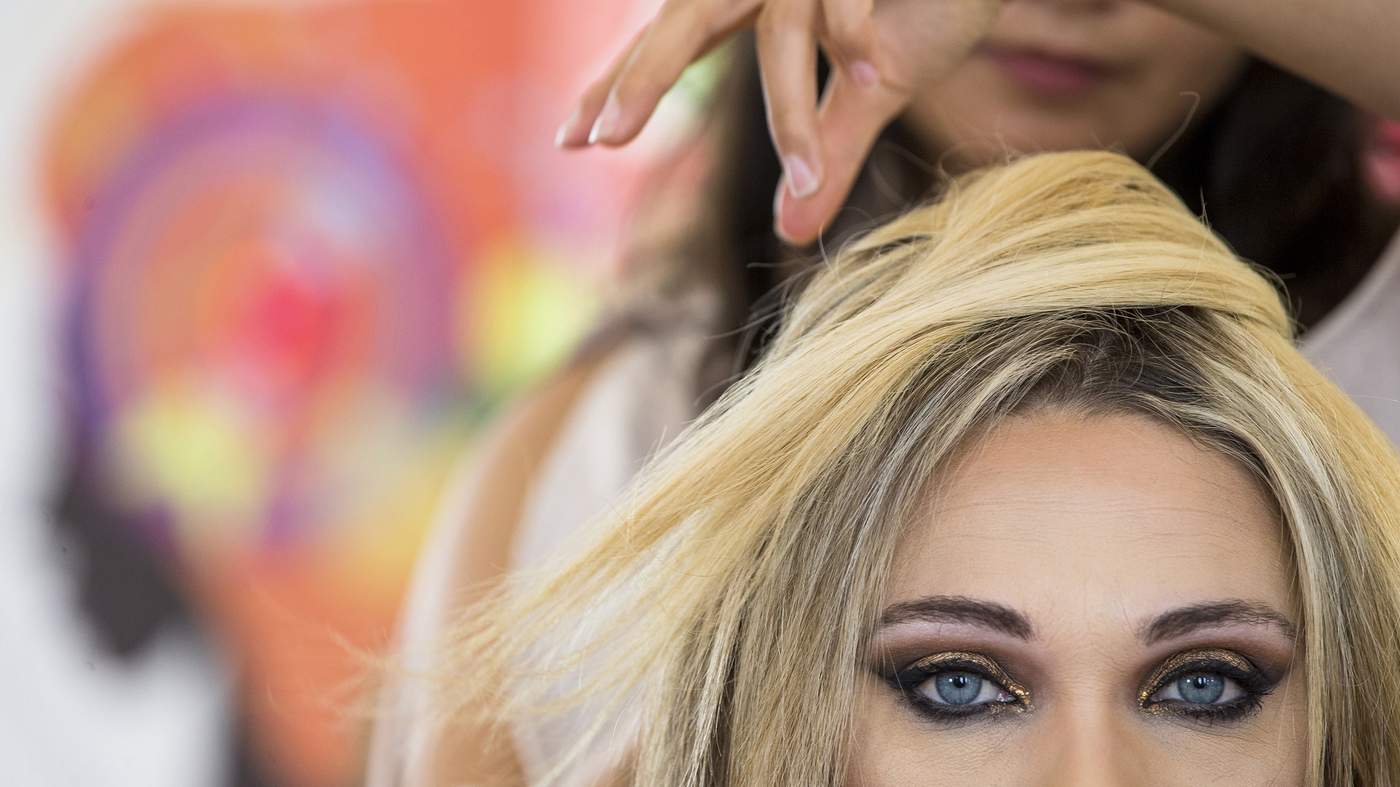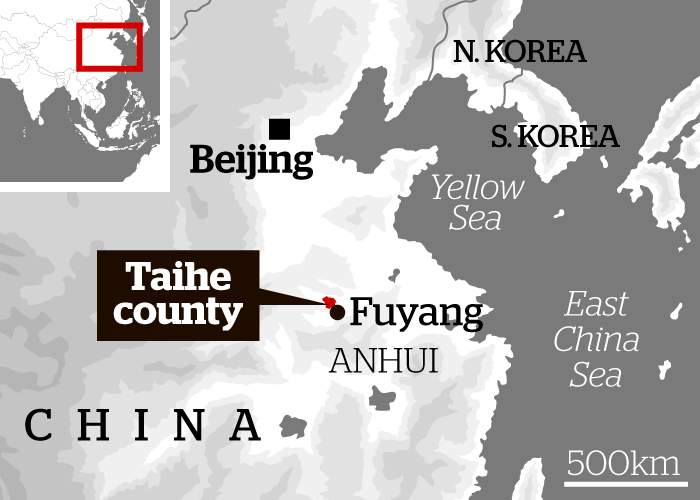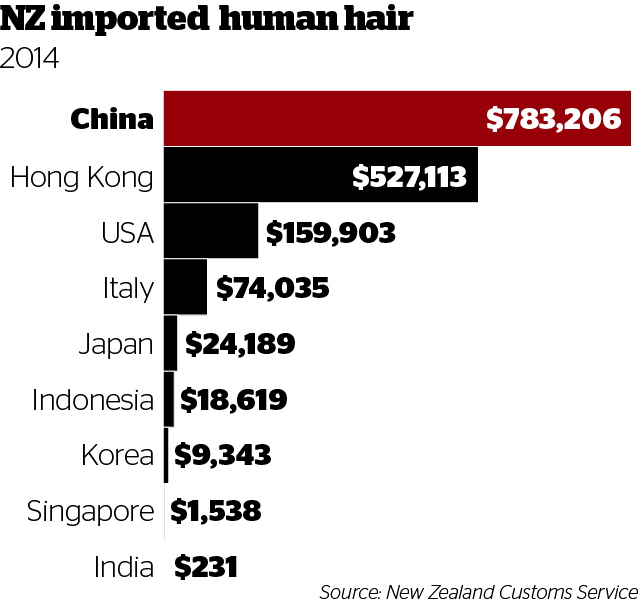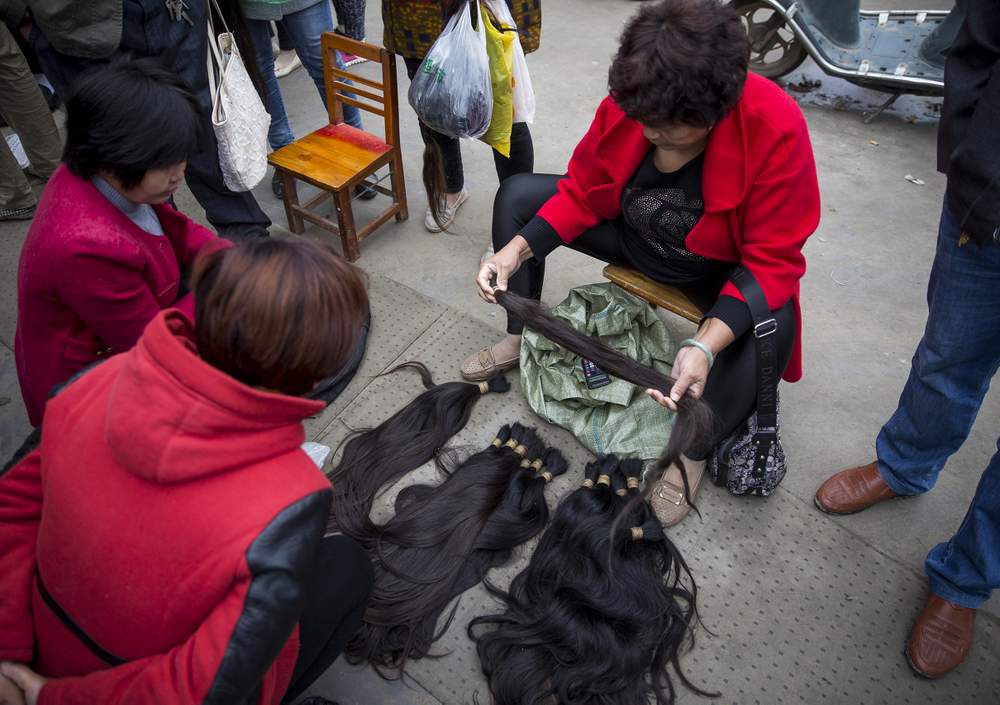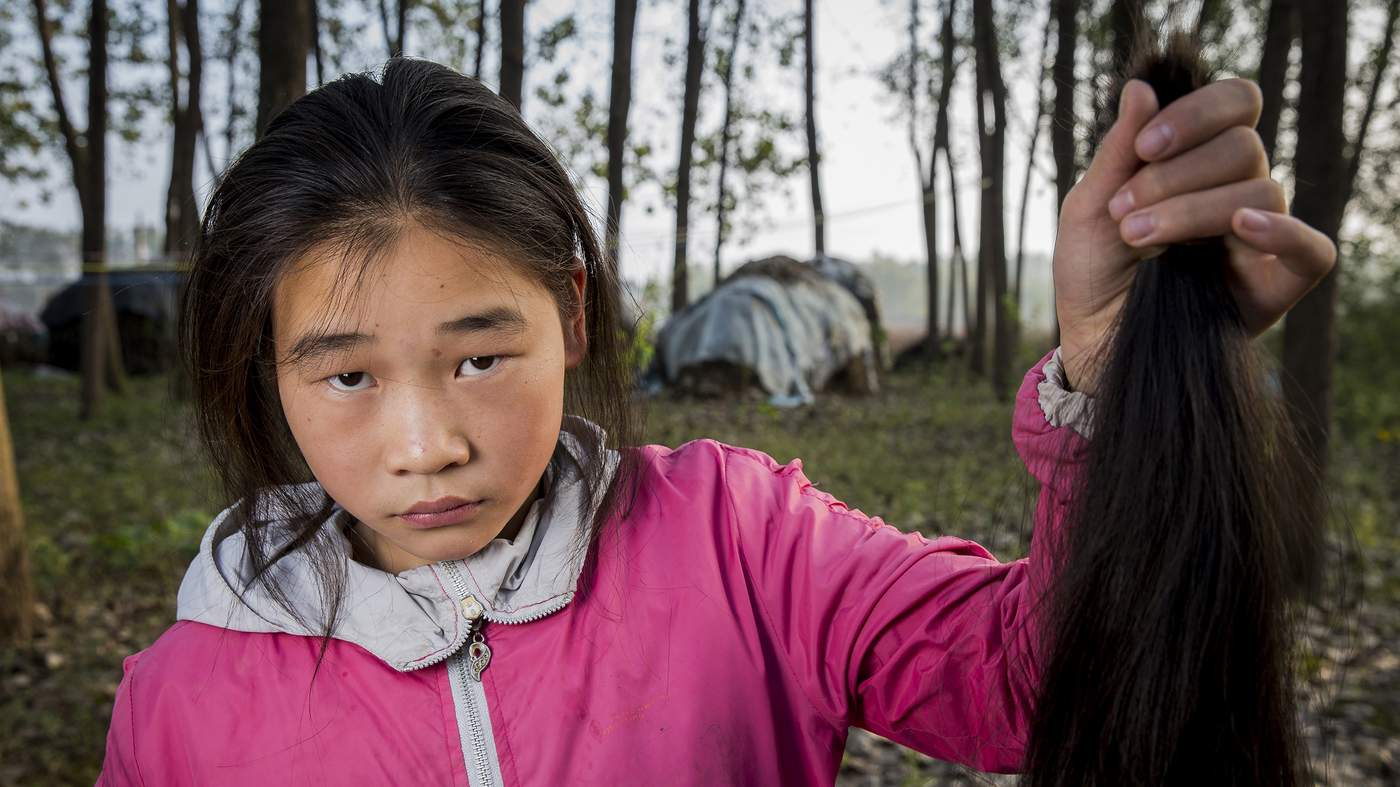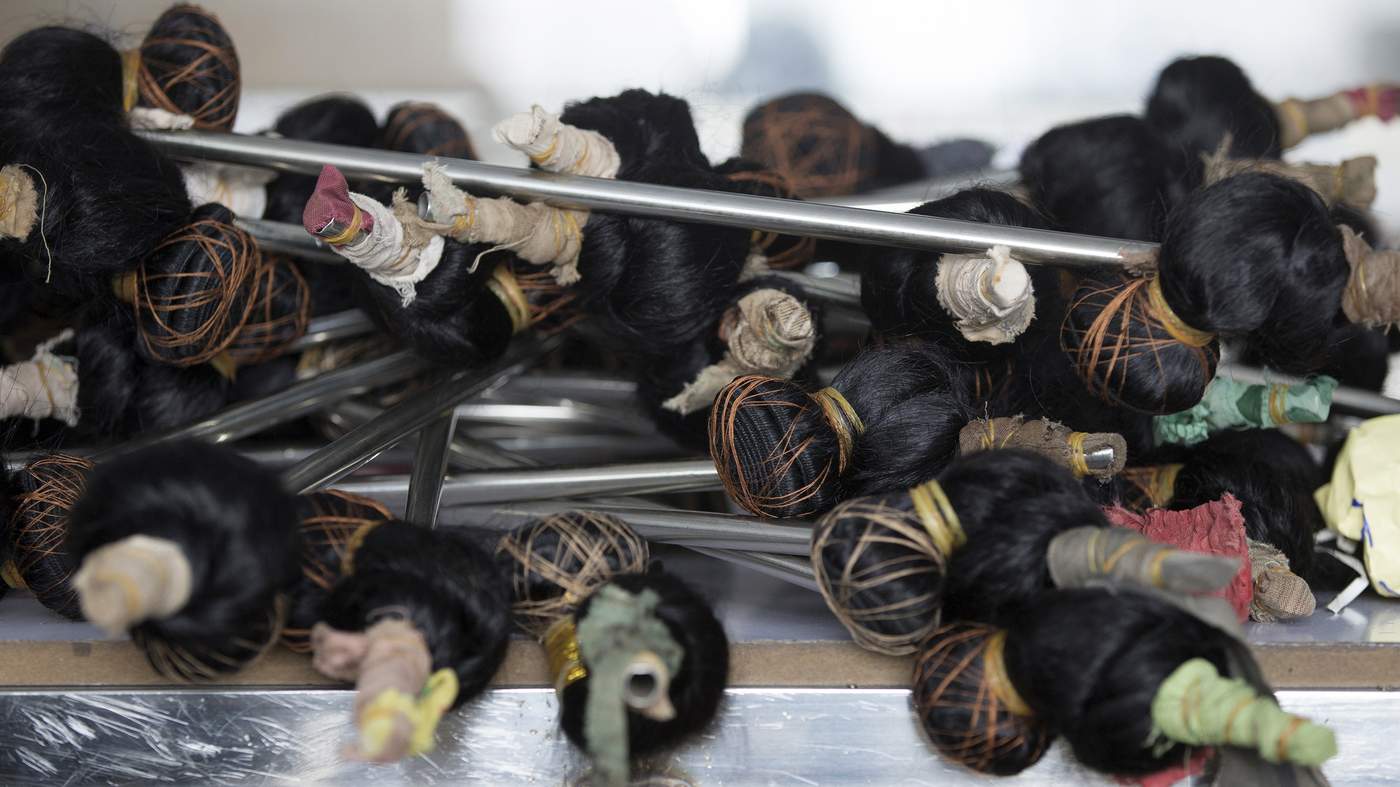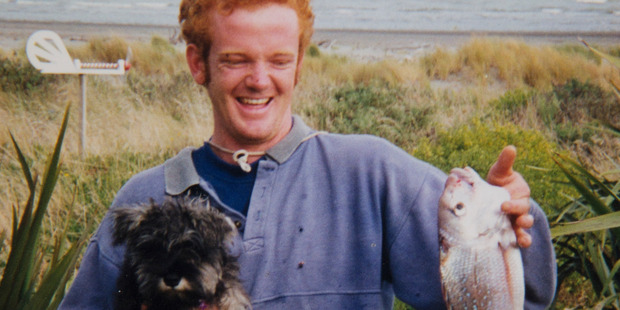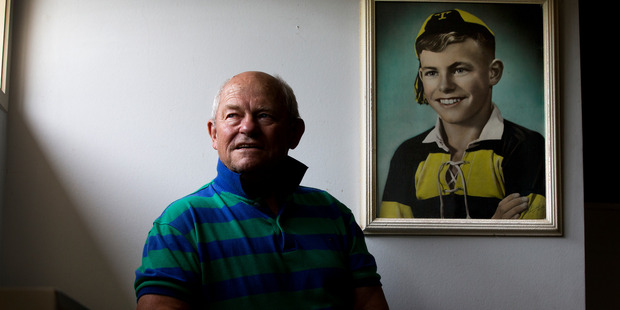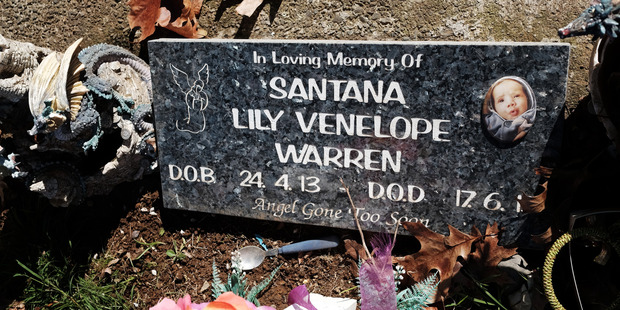In the billion-dollar human hair trade, ponytails are cut from women in the East and sold to women of the West.
It’s an unregulated industry built on exploitation with hundreds of thousands of kilometres of hair - enough to wrap around the world many times over - moving freely and silently across continents.
Most of the hair is grown in China and during the manufacturing process it is disinfected, steamed, boiled, dyed and sewn. Each step further erases any traces of its original owner.
By the time it’s sold in New Zealand as perfectly packaged extensions, the women behind the hair have been rendered invisible.
Shelley Saunders, for example, has never given the owner of her extended hair a thought, despite wearing it for six months.
Sitting in a salon in Royal Oak having 60cm ombre extensions re-taped into her roots, 24-year-old Saunders says she’s “honestly never thought about” the origins of her hair.
“The best way for me to explain it is that I never actually think about the cow when I eat a burger.”
Saunders, a school teacher, says she loves her extended locks: “The feel of it being long and totally natural.” Her students have “no idea” it’s not her own.
The only downside to extensions, Saunders says, is that her boyfriend can’t run his fingers through her hair because it’s chock-a-block with tape.
The extensions being woven into Saunders’ scalp are part of the average $2.5 million worth of human hair New Zealand imports every year - the equivalent of about 62,500 ponytails.
Hair extensions can cost anywhere from $700 up to $2000 per head in New Zealand. A ponytail grown over three years in China might fetch its owner $80, if they’re lucky.
Last month, the New Zealand Herald travelled hundreds of kilometres across China, the world’s biggest exporter of human hair, to investigate who is behind this booming industry and why they’ve been condemned for “harvesting human bodies for profit.”
In a small, rural village, we found 14-year-old Qingwen Liu.
A week later in Auckland, Jessica Harris, 28, sits in a plush leather salon chair on a cloudy afternoon as her long, blonde extensions are unwoven from her roots.
She sighs as she rests her hands in her lap; her pink acrylic nails matching her pink Barbie singlet.
She too has done this before.
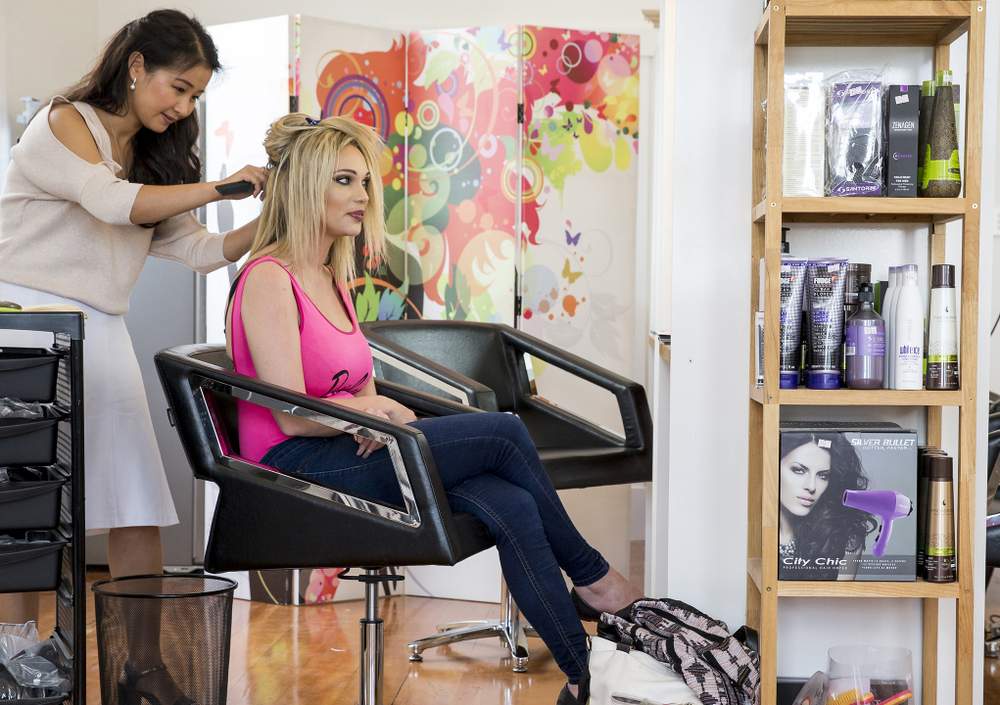
Jessica Harris
In fact, she sits in the Beauty Transformers salon on Dominion Rd every six weeks to get her extensions pulled out and reapplied closer to her roots to keep up with her natural hair growth.
Harris, who owns an adult entertainment promo agency, is a self-confessed “hair addict” and for the first time she’s asked to think about the ethics behind the extensions she’s been wearing for the past decade.
“I feel sad, but I feel sad every time I eat a chocolate bar.
“Look around at everything you consume, absolutely everything, and you can find a sad story on it,” Harris says, her blue eyes earnest under her gold eye shadow.
“If you’re going to think about it, this is kind of down on the scale [of exploitation] as there is no physical violence or anything.”
Women in the West like Harris spend thousands of dollars on hair extensions for added length, extra volume and, sometimes admittedly, for vanity.
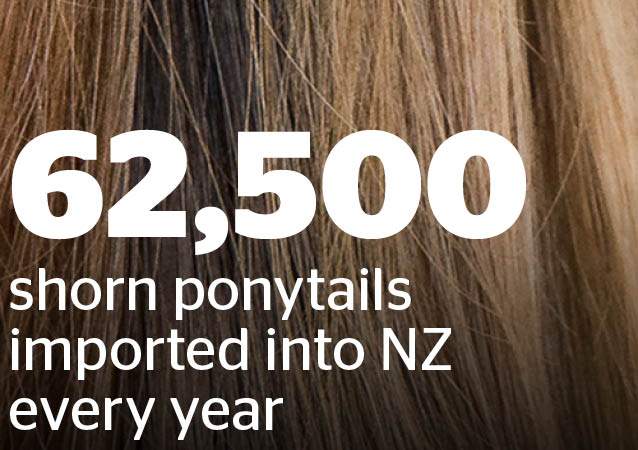
Long, luscious hair makes women feel more feminine, “and you look sexier,” says Rita Vhargava, owner of downtown Auckland salon Union Hair and Brows.
The transformation from short to long hair is “a complete makeover”, she says, explaining why she is seeing at least 20 women a week booking in to have extensions, which can last up to six months, taped, glued or woven into their roots.
Consumers don’t want to think about the women who grew their hair or the chains of labour that led to it landing on their scalp because, hair trade academics argue, the thought of wearing someone else’s body part is grotesque.
We contacted 22 salons across New Zealand that specialise in hair extensions and found demand has almost tripled in the past five years. But not even the hairdressers who work with these products know where they’re coming from.
The few who had questioned their suppliers about the women behind the hair told us they’d never been asked about it by customers.
“Clients care about the price; they don’t care about the origin,” says Roxanne Jefferies, manager of Kattygurl salon in Royal Oak.
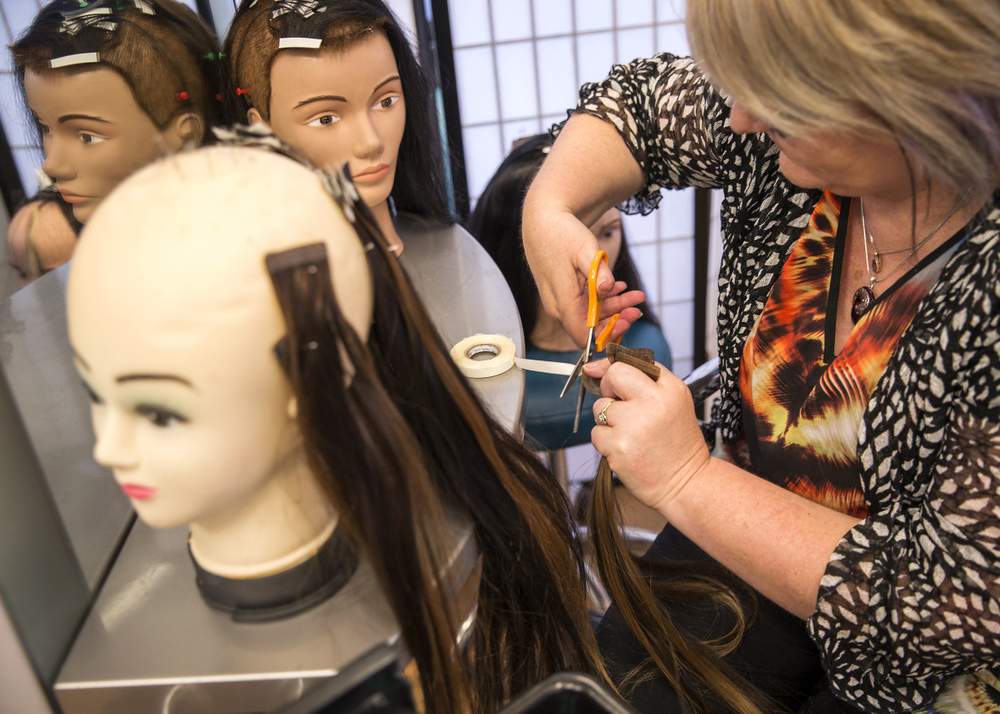
It’s widely accepted within the industry that the most ethically sourced hair comes from temples in Chennai, India, where women shave their heads for religious sacrifice, Jefferies says.
Indian hair is the most similar in texture to Caucasian hair and it’s been willingly donated, which means it’s more valuable to Western suppliers and in turn more expensive for consumers.
Three packs of 60cm Indian temple hair, costing $370 each, have gone unsold in Jefferies’ salon for two years because, she says, no one wants to pay more for ethically sourced hair.
“We would rather not support the unethically sourced hair, but we can’t. We would have an empty shop and no customers without the Chinese products.”
Hair extensions are sold in New Zealand salons like slabs of meat in butcheries.
Dozens of different varieties of hair - curly, straight, blonde, brown - hang side by side on the salon walls, wrapped in plastic and waiting to be selected.
Customers can choose the cut, weight and type of product they want.
The better the quality, the higher the price.
By July this year, New Zealand had imported almost $1.3 million worth of human hair, according to data obtained under the Official Information Act. More than 60 per cent comes from China and Hong Kong.
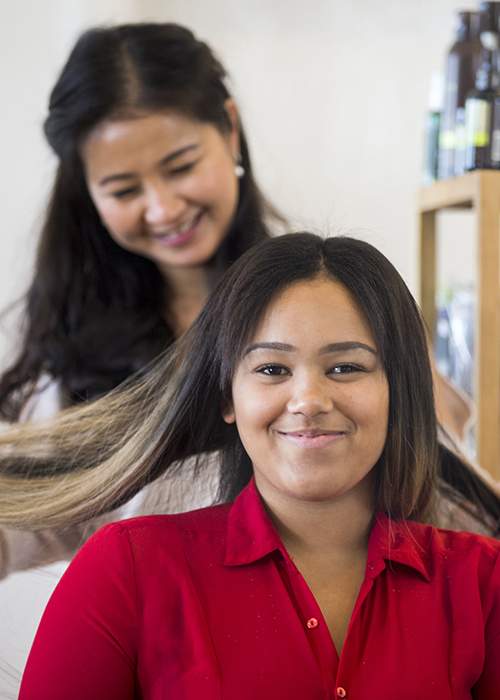
Maeve Chea and her client Emiletha Holland
For Maeve Chea, who has been working with extensions for around eight years, June was the biggest month on record at her Beauty Transformers salon.
She believes the popularity of extensions is growing because of social media and celebrity culture. Beyonce reportedly has a hair collection worth US$1 million and reality television stars such as the Kardashians change their hair colour and length every month.
Plus, in today’s consumer-driven world, “when we want something, we want it now - and this stuff takes years to grow,” Chea says, while unweaving Emiletha Holland’s 60cm blonde ombre add-ins in late October.
“When my clients are done, they walk out a better person, with more confidence; I see this great transformation,” she says, slowly pulling out a strip of Holland’s extensions, exposing the 17-year-old schoolgirl’s cropped, black curly hair underneath.
Holland doesn’t like looking in the mirror when her extensions are not there: “I feel like a boy without them in,” she says, cringing as she covers her natural hair with her hands.
The crowd of people who have gathered to watch the cut are blocking the traffic, causing a jam of electric tuk tuks.
Liu sits on the wooden stool in the middle of the mayhem; a Wednesday afternoon spectacle.
She doesn’t talk. She doesn’t cry. She doesn’t smile.
Some sections of her hair are shorn to the scalp. In other parts she has thin wispy leftovers, worthless to the agent.
She runs her hands over what remains and tries but fails to pull it back into a ponytail.
“A little bit sad,” she says, cuddling into her mother.
Shaoyun wraps a rubber band around the top of Liu’s freshly cut ponytail and pulls out a handmade set of scales from the underseat compartment of his motorbike. Using his long, yellowing thumbnail he secures the ponytail onto a hook and records its weight before dropping it into a plastic sack with all the others.
Less hair is being sold now compared to five years ago, Shaoyun says, because fewer people in China are living in desperation, which means he has to drive further into the countryside to find donors.
He’s been working as a hair agent in Taihe for 20 years and on average collects around 200 ponytails a month - 50kg of hair.
The youngest girl he’s shorn was 10 years old.
“Sometimes the parents want to sell, but the little girl doesn’t,” he says. He’s had girls try to run away and then be carried - or dragged - back to his wooden stool by their parents.
“Sometimes, when the haircut is finished I see them just look in the mirror and cry,” Shaoyun says, running his index finger down his cheek.
Whispers of similar horror stories still circulate.
The Guardian and other media outlets have reported that women have been held down and had their hair chopped off by gang members; slum children have been tricked into having their hair cut off for toys; and female prisoners have been forced to have their heads shaved so those in charge can sell it on.
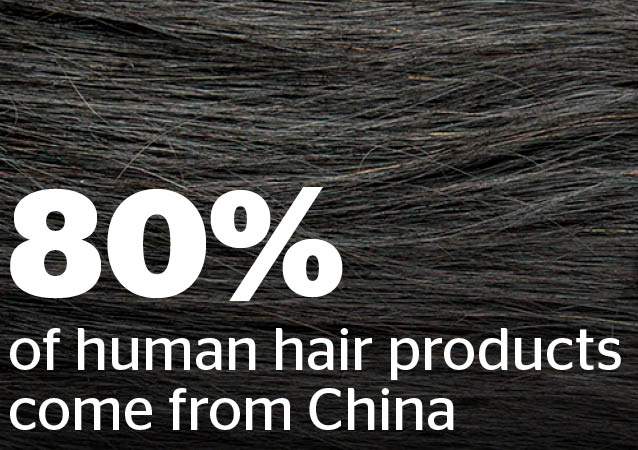
In New Zealand, human hair is imported as a beauty accessory and not a body part so there are no restrictions, regulations or prohibitions on the product. That means it’s impossible to determine whether it’s been willingly donated, sold or stolen by the time it lands on our shores.
Hair is big money and everyone in China knows it, says Gang Guo, the owner of a hair factory in Taihe that exports up to 10,000 extensions to the United States every week.
On a leather couch in his air-conditioned boardroom, Guo says he’s aware of the value of each raw ponytail, but has never heard of hair being stolen from a woman’s head.
“It’s very hard to say it’s not happening like this, though,” Guo adds.
Likewise, Garry Boyd, co-owner of Auckland’s Kattygurl salon, concedes he has no idea - and no way of knowing - if the hair he imports from China has been ethically obtained or manufactured.
“There is probably exploitation going on, but there is nothing we can do about this from our end,” he says.
Taihe’s biggest hair factories are like gated communities and because they require permission from the local government to allow foreign media on their premises, we were only able to gain access to witness this process by posing as New Zealand business owners.
Behind the factory’s barbed wire fences, you can immediately taste the acidic smell of stagnant peroxide and hear the whirr of sewing machines.
The amount of raw hair stored inside is hard to fathom; millions of dollars of ponytails cut from the heads of thousands of women is stacked in crates one on top of another, some reaching the ceiling.
Loose strands of hair carpet the tiled floors and horse tails sit in sacks beside human hair, raising questions about whether or not animal hair is surreptitiously padding out the manufactured products - which the factory owners deny.
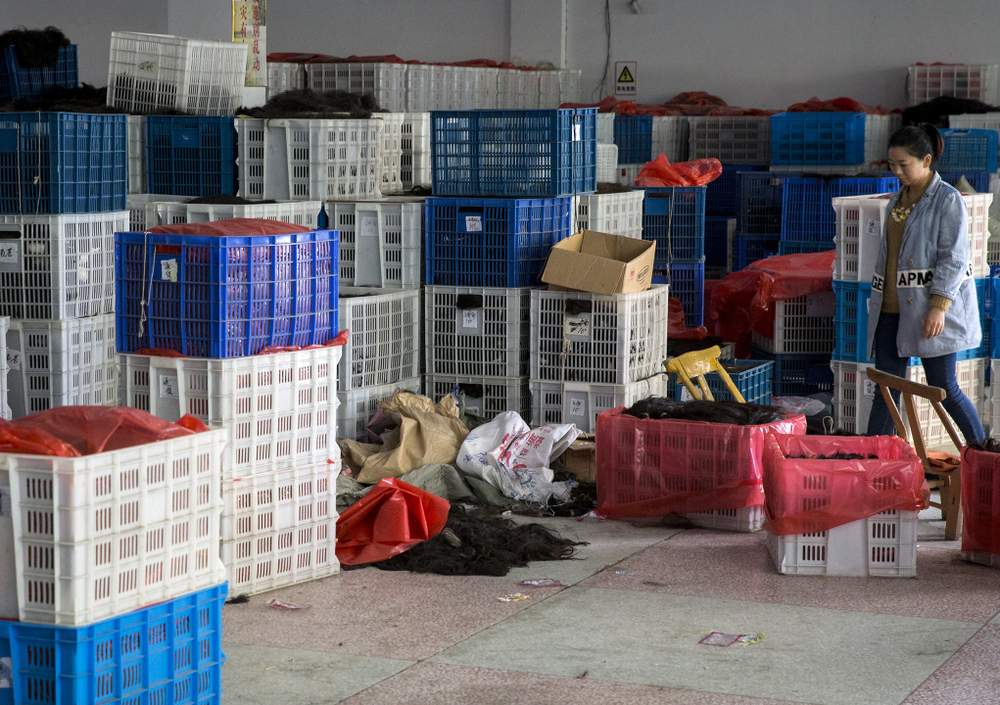
More than 1000 workers are inside - some paid as little as $2 an hour and nearly all female. They sit on small, wooden stools combing the hair through nails, soaking it in conditioner and dyeing it in metal barrels.
Those soaking the hair have wrinkled fingers and those dyeing the hair wear face masks to counter the overpowering level of peroxide in the air.
Each room in the factory fulfils a different step in the process; in one room workers use pingpong paddles to flatten the hair, in another they use steel rods to curl it and across the hall they use electric razors to even it out.
In the sewing room, 15 workers sit at machines going full throttle, not taking their eyes off the hair as they slowly feed it through their fingers. Hundreds of metres of sewn hair fall in folds on the floor near the workers’ feet, while discarded strands blown out of the machines gather on the walls like cobwebs.
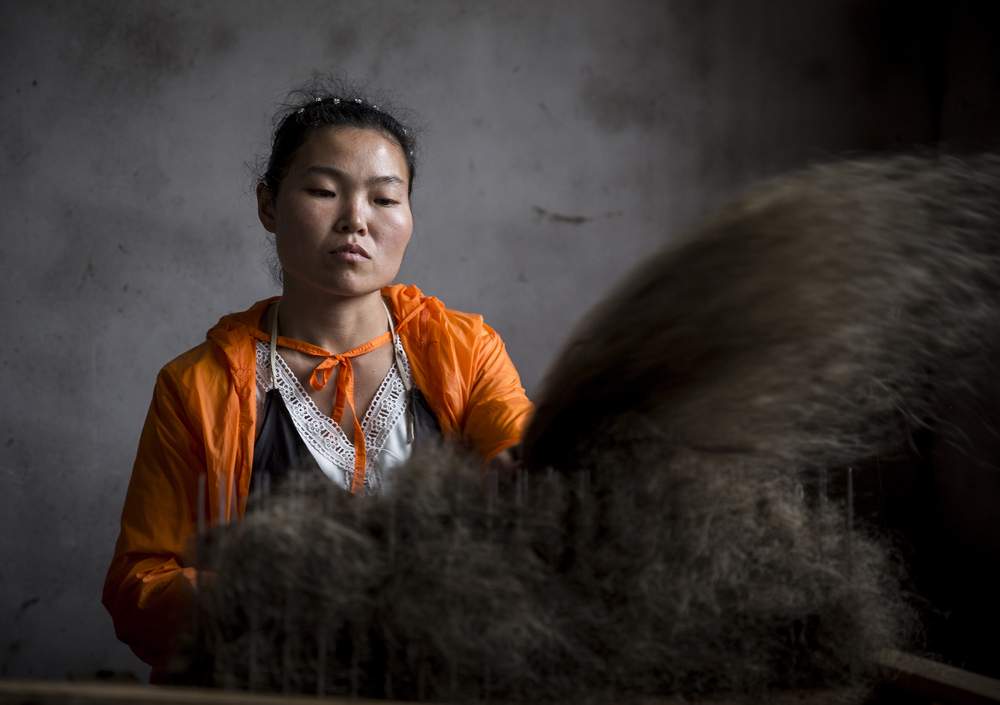
One factory can produce 5km of hair a day, 1825km a year.
Despite 70 per cent of the hair processed in China being Chinese and coming from girls in the countryside like Qingwen Liu, the final products are being mislabelled as Brazilian or Peruvian to increase the price for Western suppliers, many who believe Chinese hair is the poorest quality.
By the time the extensions are completed, each individual package could carry the hair of up to 200 women and it would be impossible to know who they were or where they came from.
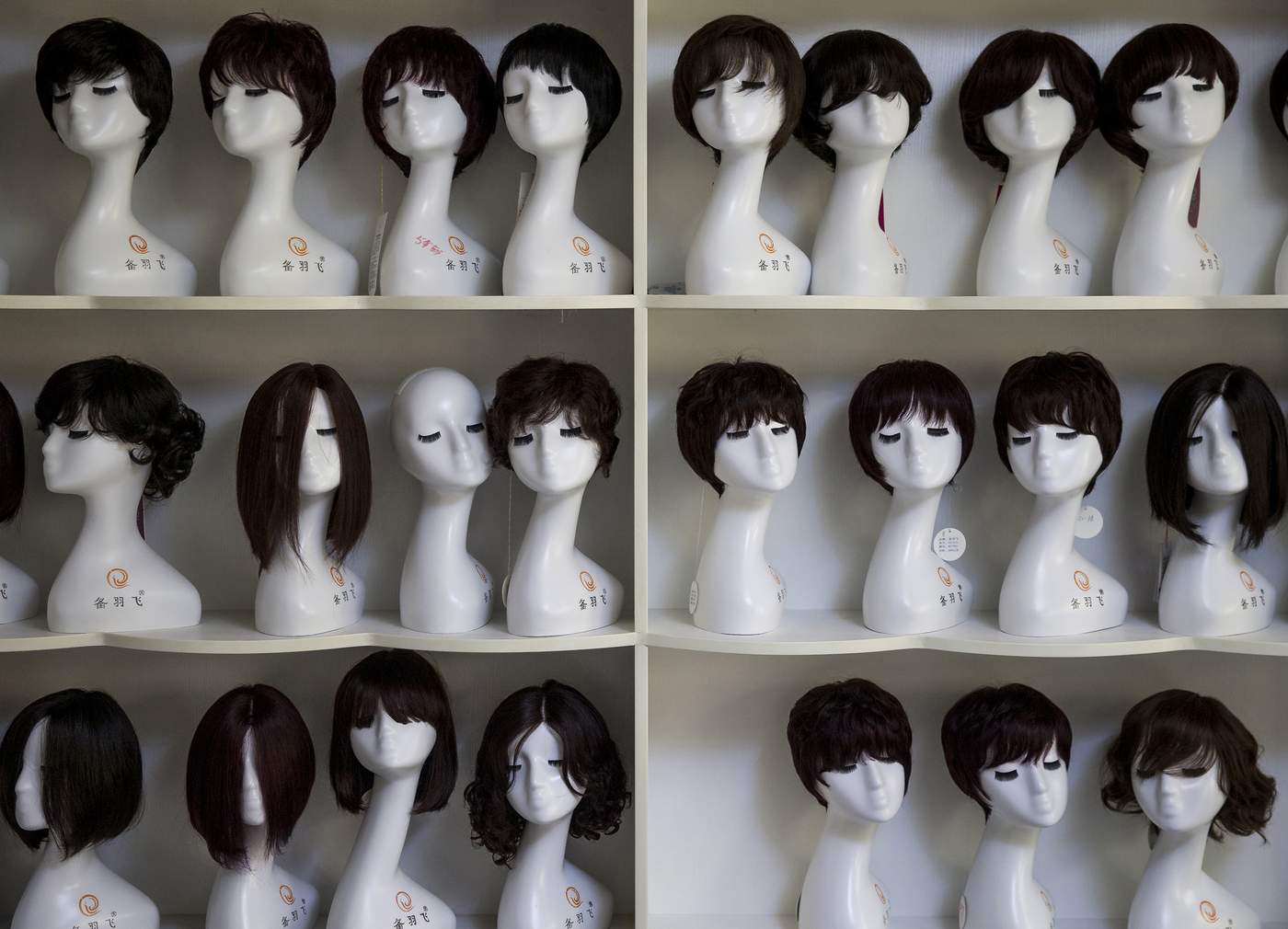
The journey hair takes from rural villages in China and temples in India to upmarket salons in places like New Zealand is a clear example of global capitalism’s exploitation of impoverished countries, says Dr Esther Berry, a Canadian hair trade expert.
Women who wear extensions are playing out a narrative similar to Rapunzel, Berry wrote in a scholarly article on the Indian hair trade, in which they are clambering “up the West’s ivory tower” on borrowed braids.
Since before Biblical times, long hair has been associated with femininity and beauty and the producers in this trade are left almost bald to provide consumers with the material to “attain a highly contrived form of feminine beauty”, she says.
To Tim Hazledine, a professor of economics at Auckland University, the hair trade is effectively “farming humans”.
“We’re talking about harvesting human bodies for profit.”
Hair may be a renewable resource, but it grows slowly, Hazledine says. And to keep up with increasing First World demands “there must be a lot of people whose hair is getting cut out there”.
“People get upset about fair trade in coffee, so why not fair trade in hair?” Hazledine asks. “If it’s not an illegal thing to trade, the next question should be about making sure it’s all done reasonably humanely.”
Alicia Collin, 33, is a professional dressage rider and Auckland businesswoman. Her long blonde extensions are the envy of her friends. Unlike some consumers, Collin has thought about the women whose hair she wears.
“I feel like the poor girl who has grown this gets such a small portion in the supply chain and it makes such a big difference in my life.”
Collin used to be ashamed about wearing extensions, but now thinks it’s just another luxury item like makeup or expensive clothes. The women growing and manufacturing the hair in China are “no different to those sitting in sweatshops in India”, Collin says.
“If they are getting something out of this for their own personal benefit, I don’t see any issue with First World women wearing them.”
The desire for long, luscious hair is a lot stronger than any sense of guilt or immorality consumers would have learning the dark secrets of the hair trade, says Berry.
Hair-extended women don’t want to think about the fact that girls like Liu are selling part of their bodies or that once the hair has been shorn from their heads, it will be sold along the supply chain likely for more than the girls will ever be able to earn in a lifetime.
In our world, Berry says, “beauty is just more powerful”.
The first time Qingwen Liu had her hair cut off she was 11 and her mother cried.
The ponytail that took her years to grow fetched her family, who farm corn for a living, $40 - enough to buy rice to last almost two months.
That was three years ago and now Liu’s hair has grown back down to her waist, the hair agents have returned.
Sitting on the worn, wooden stool, Liu is expressionless as her hair tie is removed, allowing the silky black layers to fall around her shoulders and across her face for the last time.
A handful of hair from the left side of her head is brushed upwards, towards her roots, to eliminate any shorter strands before it is abruptly cut off in seven short snips. It’s cut with a pair of household scissors about half a centimetre from her scalp.
She winces at each snip.
Young girls watch from a distance; close enough to see, but safely out of Shaoyun’s reach.
As pieces of Liu’s lifeless ponytail dangle before her, she says she would prefer to keep her hair long, like her friends, like “girl’s hair”, however she’s not angry with her mother who arranged the cut.
“If my family were rich, I don’t need to cut it off,” she says.
But they’re not rich and so in three years, she’ll do it again.
Back in the Royal Oak salon, when Shelley Saunders is asked if she wants to see a photograph of a girl in China from the other end of the extension chain, a girl who lost her hair, she laughs and says: “Yes, I’m ready to meet my sponsor.”
She stops smiling when she sees the photo of Liu.
“Wow, that’s really sad,” she says.
To Saunders, Liu’s expression is the most upsetting. She moves a little closer to the photograph, Liu’s face only inches from her own; “It looks like she was forced to cut it off,” she says.
Averting her eyes from the photo, Saunders adds: “It makes you think about your life and how you have so much choice and freedom.”
She then turns her head slightly to the right, so her hairdresser can re-tape another strip of human hair into her head.
Black Gold was an investigation by Olivia Carville (Olivia.Carville@nzherald.co.nz) and Mike Scott (Mike.Scott@nzherald.co.nz). Designed by Paul Slater.
The project was funded by the Asia New Zealand Foundation.
Special thanks to translator Huailin Li.

